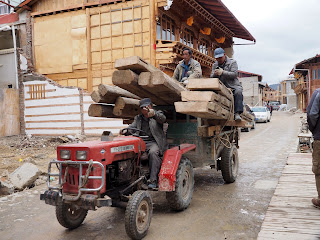First thing this morning it was off on a walk to the
monastery complex. We saw pilgrims working their way around the complex (always clockwise) by prostrating themselves every couple of steps.
The first stop was at a Stupa with the usual prayer flags.
and then to a monastic house.
Our hotel is immediately adjacent to the Ganden
Songzanglin Monastery so it was a very short walk. This is probably the best sight in all of Shangri-La. The interior is much like that of many other monasteries that we have visited. It is the exterior and location (mountains around, and the lake in front), that really makes it special.
There were very interesting golden details all around the buildings.
This monastery is one of the thirteen Tibetan monasteries in the Kangba
Region, where Tibet, Yunnan and Sichuan join. It holding about 700 monks and one
living Buddha. It dates from the 17th century and
locals refer to it as the Lesser Potala after Potala Palace in Lhasa,
Tibet. There are distinct similarities.
The dominant group in this area is Tibetan and the area
use to be part of Tibet before Tibet was taken over by China. Other minority groups include the Han and
Bai.
The largest building in the complex is a ceremonial hall
where monks meet, worship, and debate.
The hillside in front of the monastery is covered with small homes that
house the monks. The families of the
monks own the homes.
The next stop was at a typical Tibetan home. The lower levels were traditionally reserved
for housing animals during the bitter winters, the upper levels occupied by the
family and the level just under the roof used for storage, including drying
grain. It also makes a good place to store your motorcycle.
There is one great room with a
wood stove for cooking and heating, and bedrooms opened directly off the great room.
The cook stove was directly under an opening in the ceiling to catch the smoke.
After lunch there was a stop for a walk-through in Old
Shangri-La. Unfortunately this area of
the city suffered a major fire in January, 2014 and 1000 stores and 400 homes were
destroyed. Apparently the water pipes to
be used by the fire department to fight fires ran above ground and since the
fire started in winter the pipes were all frozen so they had no water to fight
the fire.The area is now being rebuilt using the traditional
architecture. However, right now much of
it did not make for interesting touring.
 |
| Note the stove pipe coming out of the glass window!! |
 |
| Hauling lumber for the construction projects. |
 |
| Under Construction |
 |
| A newly constructed building |
There was a stop Guishan Hill
to see another temple.
Adjacent to the temple was the Giant Prayer Wheel, the largest in the world at 20 meters high and 36
tons. Supposedly it can be turned by one person. However, it seems to need a lube job and currently it takes a number of people
pushing to get it going…the four people at the Prayer Wheel at the time we were
there could not get it going.
If HD does not show at end of progress bar, click there for better
quality.
There were some interesting old streets to wander that looked authentic and the interesting goods for sale.
 |
| Yak Tails |
There was a building near the hill that housed a
topographical relief model of the Shangri-La including Lijiang. The entire area seems to be nothing but
mountains.




























No comments:
Post a Comment